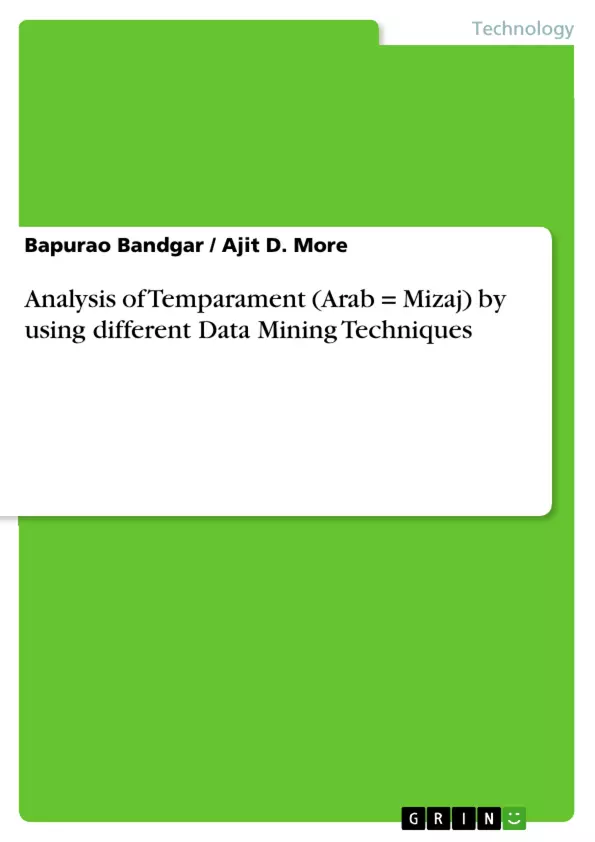There are various classes of temperament of the persons. Mizaj is the same as temperament in Unani Pathy of Arabic. Here we have collected the data on different attributes various backgrounds and field for both male and female persons from Unani Medical College, Pune. We have tried to apply the Data mining rule Classification, Association and Clustering by using the WEKA as Data Mining tool.
It was tried to classify the data using the various models of classification and found the Naive Bayse (NB) with train set data model showed good classification of the data into four classes with less relative absolute error and compare to J48 model and other models. These are as Bilious, Phlegmatic, Sanguine and Melancholic type. From the confusion matrix it is observed that the data has been correctly classified by Naive Bayse model. As generally the Melancholic type persons are observed very rarely therefore it showed less % of Melancholic type. According to the J48 model, the Mijaz is classified in to three types and these are as bilious, Phlegmatic, sanguine. These are classified depending upon the different attributes such as Sleeping hours, Reaction Moist, Body type, Thorax Shape, occupation and age.
It was also tried to find the relation between the attribute by applying the association rules and using Apriory model with 10 best rules. These shows that there is some strong relation between different attributes such as Reaction strength, Movement, reaction speed and fear etc. Depending upon the level of the anger the person gets troubled. Thus based on the different attributes the temperament is classified into different types.
Further it was tried to cluster the data into different groups, by using the K-Means and EM model. The EM model clustered the data into two types only, which was not correct. There are various classes of temperament of the persons. Mizaj is the same as temperament in Unani Pathy of Arabic. The data is collected on different attributes various backgrounds and field for both male and female persons from Unani Medical College, Pune.
Inhaltsverzeichnis (Table of Contents)
- Introduction
- Business Application
- Data Structure
- Tasks and methods
- Import and Export of Data and models
- Categorization of Data Mining Software into Different Types
- Mijaz
- Research Methodology
- An Introduction to the WEKA Data Mining System
- Data Mining
- Data Mining Software
- Weka Data Mining Software
- Data preprocessing and visualization
- Attribute Selection
- Errors Rules Attribute
- Classification - decision tree
- Clustering - k-means
- Association Rules
- Data Collection
- Brief Description
- Attributes
- Data Processing
- Result Analysis and Discussions
- Classification
- Association
- Clustering
- Knowledge Flow for NB Tree Model
Zielsetzung und Themenschwerpunkte (Objectives and Key Themes)
This work aims to analyze the concept of temperament (Mizaj) within the Unani system of medicine using various data mining techniques. The research utilizes data collected from the Unani Medical College in Pune, India, focusing on attributes of individuals to classify, associate, and cluster temperament types.
- Applying data mining techniques to understand and classify Mizaj
- Exploring the relationships between various attributes and temperament types
- Analyzing the effectiveness of different data mining algorithms for Mizaj classification
- Investigating the role of data preprocessing and visualization in understanding temperament
- Developing insights into the influence of factors such as sleeping hours, reaction moisture, and body type on Mizaj.
Zusammenfassung der Kapitel (Chapter Summaries)
- Chapter 1: Introduction - This chapter provides an overview of the research, including the background of Mizaj, the application of data mining techniques, and the research methodology employed. It also introduces the concept of Mizaj, its importance in Unani medicine, and the need for data-driven analysis.
- Chapter 2: An Introduction to the WEKA Data Mining System - This chapter introduces the WEKA data mining software, its capabilities, and the specific techniques used in the study, such as classification, clustering, and association rule mining.
- Chapter 3: Data Collection - This chapter discusses the data collection process, including the attributes considered, the data sources, and the methods used for data processing and preparation.
- Chapter 4: Result Analysis and Discussions - This chapter presents the findings of the data analysis, focusing on the results of classification, association rule mining, and clustering. It also discusses the implications of the findings for understanding Mizaj and its application in Unani medicine.
Schlüsselwörter (Keywords)
The core concepts and themes explored in this research include Mizaj, Unani medicine, data mining, classification, clustering, association rule mining, WEKA, Naive Bayes, J48, K-means, and EM model. These keywords encapsulate the primary focus areas of the study, which revolves around using data-driven methods to understand and analyze temperament types within the Unani system.
- Quote paper
- Dr. Bapurao Bandgar (Author), Dr. Ajit D. More (Author), 2020, Analysis of Temparament (Arab = Mizaj) by using different Data Mining Techniques, Munich, GRIN Verlag, https://www.grin.com/document/981618



